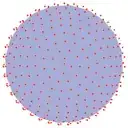What is the configuration (set of locations) of $n$ points on the surface of a sphere such that the sum of distances is maximum for $n=1,2,3,...$?
The sum of distances is measured by summing the lengths of every straight line (through the sphere) connecting every possible combination of $2$ points. All the points are on a single sphere of radius $R$.
Here's a visualization:

Acknowledgements: Based on this Physics S.E. question. Image from StackOverflow.